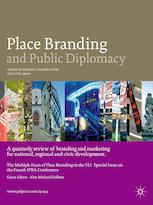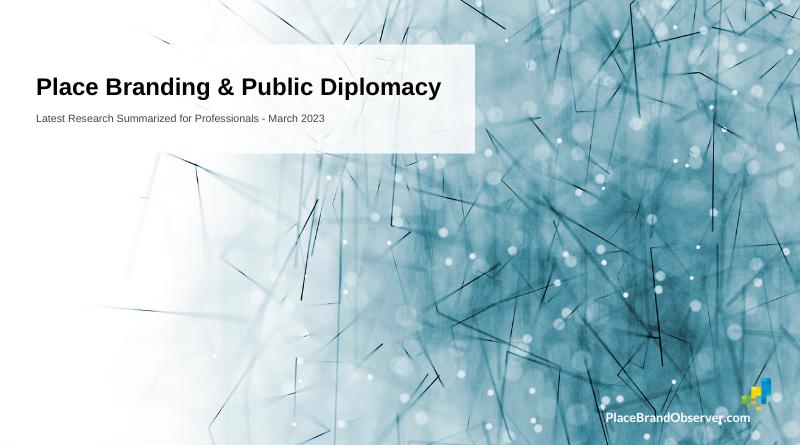In today’s interconnected world, place branding and public diplomacy have become increasingly important for cities, regions, and countries. A successful branding and diplomacy strategy can help attract investment, tourism, and talent, while also enhancing national and international reputation. However, designing and implementing effective strategies requires a deep understanding of local and global contexts, as well as the tools and tactics that can be used.
To help practitioners stay up-to-date with the latest research and insights, we have compiled a thematic summary of recent articles published in the Journal of Place Branding and Public Diplomacy. These articles cover a wide range of topics and perspectives, providing valuable lessons and ideas for anyone involved in place branding and public diplomacy.
Key Takeaways for Practitioners
Based on the insights provided by the research articles reviewed, here are five actionable points that place brand managers and public diplomats can take to improve their strategies:
- Public diplomacy can be an effective way to promote soft power, but success depends on careful planning and implementation. For example, the US Peace Corps can be an effective public diplomacy strategy if implemented properly.
- Vaccine diplomacy can be used as a way to promote a country’s image as a responsible global leader and improve its standing in the international community, as China has done with COVID-19 vaccine distribution.
- Digital diplomacy and branding play a key role in shaping public perceptions of places and nations, and strategic communication is essential to managing online conversations. The EU delegation in the Philippines is an example of this challenge.
- Emotional branding can be a powerful way to create a sense of place attachment among residents and visitors, as shown by the case of Coimbra in Portugal. Similarly, food can be an important part of a holistic approach to place branding, as demonstrated by the Basque Gastronomic Ecosystem.
- Sports can be a powerful way to promote national values and identity, as demonstrated by Brand America and public diplomacy during the Trump presidency. However, branding efforts must be sincere and genuine, as demonstrated by the ambiguity surrounding Rwanda’s “Visit Rwanda” campaign.
Soft Power and Diplomacy
Public diplomacy can be defined as the use of communication and other activities to influence foreign publics and promote national interests. Several articles in the recent research highlight the role of public diplomacy in promoting soft power, which refers to the ability of a country to attract and persuade others without coercion.
One article by Matthew T. Palmer, Eugene Bempong Nyantakyi, and Jami A. Fullerton explores the use of the US Peace Corps as a public diplomacy strategy. The article argues that the Peace Corps can be an effective way to promote mutual understanding and goodwill between the US and other nations, but that its success depends on careful planning and implementation.
Another article by Seow Ting Lee examines the concept of vaccine diplomacy and China’s COVID-19 soft power play. The study analyzes how China has used vaccine diplomacy to promote its image as a responsible global leader and improve its standing in the international community.
In “China’s Belt and Road Initiative and soft power in Pakistan: an examination of the local English-language press“, Muhammad Ittefaq, Zahid Shahab Ahmed, and Yadira Ixchel Martínez Pantoja examine the media discourse around China’s Belt and Road Initiative in Pakistan, highlighting the challenges and opportunities for China’s soft power in the region.
Clearly, China is in the soft power research spotlight right now.
“Tool selection for public diplomacy flagships: toward an adaptive model” by Biyun Zhu provides an adaptive model for selecting tools in public diplomacy flagships and offers insights into the decision-making process for selecting programs and how they fit into the overall strategy.
“The Cold War statecraft and public diplomacy: assessing US-Soviet scientific-technical exchanges” by Olga Krasnyak examines the impact of US-Soviet scientific-technical exchanges on inter-state relations and suggests incorporating the legacy of such exchanges into contemporary discussions on public diplomacy.
Digital Diplomacy and Branding
Another theme we identified in the research presented in the latest issue of the journal Place Branding and Public Diplomacy is the role of digital diplomacy and branding in shaping public perceptions of places and nations. “Helpful partner or infringing interloper? Examining discursive contestation in the engagements on the EU delegation in the Philippines’ Facebook page” by Manuel Enverga III examines the social media engagement of the EU delegation in the Philippines, highlighting the challenges of managing online conversations and the need for strategic communication.
In “Using integrated marketing communications to promote country personality via government websites“, Bo Liang and Ye Wang propose a model for using government websites as a platform for integrated marketing communications, aiming to promote a country’s unique personality and brand identity.
Culture, Emotions, and Identity
Place branding being the process of creating and managing a place’s identity to attract visitors, residents, and investment, recent research on place branding highlights the importance of city image perception and the factors that influence it.
In “Emotional branding of a city for inciting resident and visitor place attachment“, Beatriz Casais and Túlia Poço argue that emotional branding can be a powerful way to create a sense of place attachment among residents and visitors, highlighting the case of the city of Coimbra in Portugal.
Another article, “Food-based place branding as holistic place ecosystems: the case of Basque Gastronomic Ecosystem” by Norberto Muñiz-Martinez and Magdalena Florek, looks at the role of food in place branding and argues that a holistic approach to place branding should take into account the entire ecosystem of food production, distribution, and consumption.
Dian Wang, Bowen Zhang, and Xinwen Zhang investigate generational homogeneity and heterogeneity in city image perception. The study analyzes how different generations perceive a city’s image and the factors that influence their perceptions.
The research by Alberte Tøttenborg, Can-Seng Ooi, and Anne Hardy examines the application of public management lenses to place branding by exploring Tasmania’s “Go Behind the Scenery” branding strategy and highlighting the complex processes of mobilizing local support for the brand and aligning stakeholder interests, value creation, and operational capacity.
Sports, Generational Perceptions, and Politics
The fourth broad theme that we identified in the latest research examines the role of sports, generational perceptions, and politics in place branding and public diplomacy. In “Sports, Brand America and U.S. public diplomacy during the presidency of Donald Trump“, Yoav Dubinsky analyzes the role of sports in promoting Brand America and public diplomacy during the Trump presidency, arguing that sports can be a powerful way to promote national values and identity.
The research by César Jiménez-Martínez explores the relationship between foreign correspondents and nation branding in Brazil by identifying three modes of engagement: challenging, aligning with, and filtering soft power, and highlighting the potential of foreign correspondents as collaborators or antagonists of soft power initiatives.
“Visit Rwanda”: a well primed public relations campaign or a genuine attempt at improving the country’s image abroad?” by Thomas Yaw Voets analyzes Rwanda’s sponsorship of Arsenal with “Visit Rwanda” messaging as part of a state-led strategy to present Rwanda as a stable and attractive destination for visitors and investors. However, reports suggest the strategy is insincere and aimed at distracting from human rights violations, leading to the conclusion that Rwanda’s branding efforts appear ambiguous and primarily marketing-focused, with benefits that may be too good to be true.
Browse all research articles in the latest issue of Place Branding and Public Diplomacy here
 Place Branding and Public Diplomacy
Place Branding and Public Diplomacy
Published by Palgrave / Springer
Place Branding and Public Diplomacy is the first and only journal to concentrate on the practice of applying brand strategy and other marketing techniques and disciplines to the economic, social, political and cultural development of cities, regions and countries.
Edited by James Pamment and Robert Govers | See editorial board
Looking for more on place branding research? Visit our place brand theory hub


